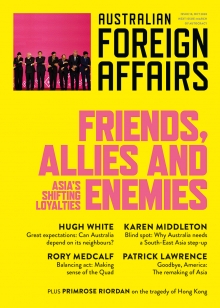
This extract is featured in Australian Foreign Affairs 10: Friends, Allies and Enemies.
To read the full issue, log in, subscribe or buy the issue.
For half a century, Australian strategic policy has shifted uneasily between two poles: self-reliance in the defence of Australia, and the closest possible alignment with and dependence on the United States. But the Australian government’s 2020 Defence Strategic Update, released in July, marks an important change in direction. Both approaches are largely abandoned, and instead, Australia will seek its security principally as part of a coalition of Asian countries. The government plainly hopes that this coalition will be led by the United States, but that is not taken for granted. We no longer repose our trust in America alone, and if America fails us then we will look not to ourselves but to our Asian neighbours – as John Curtin might have put it, “free of any pangs”. This raises critical questions. Can Australia credibly depend on our Asian neighbours for our security? What are the alternatives?
The government’s abandonment of self-reliance as the country’s primary strategic objective is a particularly stark change. Every defence policy statement from 1976 to 2013 has declared this to be Australia’s highest priority. The 2016 Defence White Paper steps back from that by stating that defending Australia is one of three core missions, along with contributing to operations in Maritime South-East Asia and the South Pacific, and to global coalitions. Self-reliance is hardly mentioned. But this year’s update goes much further. It makes no mention of the defence of Australian territory specifically. We are left to assume that Australia falls within the expansively defined “immediate region” – covering everything from New Zealand to the borders of India and China – which is the new focus of Australian defence planning. The priority, it seems, is to build forces to fight alongside other countries to defend stability and order across this region. Likewise, self-reliance is only mentioned in relation to the ill-considered idea to put deterrence at the heart of Australia’s defence posture. Thus, decades of commitment to developing and sustaining the capacity to defend Australian territory independently from direct attack have been summarily jettisoned.
At several points the update dutifully reiterates Canberra’s commitment to the US–Australia alliance and its confidence in America’s role in Asia, but the alliance is no longer accorded the unique status it has held for so long in Australia’s strategic posture. Instead, it is listed merely as one of several important relationships. For example, the foreword refers to strengthening engagement with “the United States, Japan, India, ASEAN and other allies and partners in our region”. More tellingly, the opening of Chapter 2 refers to the development of strategic relations with countries in our region – not until paragraph 2.7 is there any substantial reference to the United States, and that says merely that priority will be given to cooperating with America in the immediate neighbourhood. Nowhere is there a clear and sustained description of the overriding significance of the US–Australia alliance of the kind that was set out over more than three pages in the 2016 Defence White Paper.
The impression that Australia is de-emphasising its alliance with the United States is amplified by the limits placed on Australia’s willingness to support America. In contrast to the 2016 White Paper, which gave equal priority to operations throughout Asia and globally, the update stipulates that commitments in North Asia, as well as in the Middle East and elsewhere, have lower priority than those within the immediate region. The downgrading of North Asia is especially significant, because that is where America faces its most serious flashpoints with China and would most earnestly seek Australia’s support. The update seems to be warning the United States not to expect Australian support in a war with China over Taiwan. Canberra’s apparent downgrading of the relationship with Washington is reinforced by the fact that, in June, Minister for Foreign Affairs Marise Payne delivered a major speech offering an overview of Australia’s foreign policy and failed to mention the United States once. That, surely, is a first.
Anxieties in Asia
It is easy to understand why the government is stepping back from these two enduring pillars of Australian strategic policy. The reason is China, which the update plainly identifies as the major source of risk in the decades ahead. Not since the late 1960s has an Australian government so bluntly named China a potential military peril. China’s re-elevation to a strategic threat changes everything.
Take self-reliance. The idea that Australia could defend itself independently only began to look credible in the early 1970s, as fear of China evaporated. The nation had loomed as Australia’s primary threat throughout the 1950s and 1960s, until Whitlam’s and Nixon’s openings to Beijing in 1972. Indonesia then became the only country that could present even a remotely credible military challenge, and it became for decades the unstated but unmistakable focus of Australian defence policy. That made defence self-reliance achievable, because Indonesia’s air and naval forces have always been weak. But China has the capacity to seriously contest Australia’s air and naval superiority in its maritime approaches. No government has ever suggested that Australia should aspire to defence self-reliance against the more serious kinds of attack that China could launch in the decades ahead. Most among Australia’s strategic policy community assume it would be impossible. So as China looms again, now much more powerful than it was in the 1960s, the government is abandoning self-reliance and returning to the idea that Australia must rely on others in defending against threats that seem too big to confront alone.
As China rose in the late 1990s and early 2000s, it seemed natural and even inevitable that Australia would look to the United States for protection, and be willing to do more to support them in return. This was an important theme in the Howard government’s 2000 Defence White Paper, in which the capability to contribute forces to a US-led coalition in a war with China began to weigh alongside the demands of self-reliance against Indonesia. Since then, and notwithstanding the distractions of the War on Terror, many major defence investment decisions have been made with this imperative in mind. By the time the 2016 White Paper was published, it was clear – if not explicit in the document itself – that supporting America in a war against China had become the primary strategic objective of Australia’s defence forces. It was confidently assumed in Canberra that Washington would be successful in confronting and containing any Chinese threat to Australia or to the regional order.
Now that confidence has been shaken. The most obvious reason is Donald Trump. His America First isolationism, his dysfunctional policy and diplomatic processes, his seeming partiality for Xi and his focus on China as an economic rather than a strategic rival all raised early doubts that America would be the bulwark against Beijing that Canberra expected. But while Washington’s eagerness to confront China has since increased, with bold talk of a “new Cold War”, its capacity to do so successfully looks less and less certain. China is a formidable rival. Its economy – far bigger relative to America’s than the Soviet Union’s ever was – makes it the most powerful adversary America has ever faced. Its massive and strategic investment in maritime forces has undermined US military superiority in the Western Pacific. Its huge trade and investment footprint give it immense diplomatic leverage. And it is deeply resolved to take America’s place as the leading power in East Asia.
Nearly three years after declaring China to be its key strategic rival, Washington still has no coherent policy to resist this challenge. The reasons go deeper than the failings of the Trump administration. They go to the fundamental question of whether America needs to preserve its leadership role in Asia enough to justify the costs and risks of containing a rival as powerful as China in China’s own backyard. China’s strength and resolve means those costs and risks will be high. Many US policymakers still underestimate all this, assuming they can face down China without breaking a sweat. They may not be so keen to wage a new Cold War when the costs of lost economic opportunities and increased defence spending, and the clear risks of major war, become clear. American voters may be even less keen. So even after the pandemic, and even under a more effective president than Trump, America’s ability to contain China’s ambitions in Asia and ensure Australia’s security over the decades to come can no longer be taken for granted. And in the short term, there is a real risk that miscalculations in Washington could spark a confrontation with China that America cannot win and that might well lead to a catastrophic regional war.
These are anxious times. Not since early 1942 have Australians felt so in need of allies, yet been so unsure of their major ally. It is not surprising, then, that Canberra is eagerly, even desperately, looking for new protectors.







